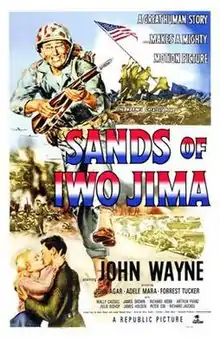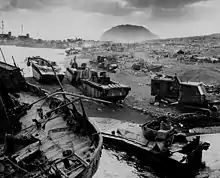Sands of Iwo Jima
Sands of Iwo Jima is a 1949 war film starring John Wayne that follows a group of United States Marines from training to the Battle of Iwo Jima during World War II. The film, which also features John Agar, Adele Mara and Forrest Tucker, was written by Harry Brown and James Edward Grant, and directed by Allan Dwan. The picture was a Republic Pictures production.
| Sands of Iwo Jima | |
|---|---|
 Original film poster | |
| Directed by | Allan Dwan |
| Produced by | Herbert Yates |
| Written by | |
| Starring | |
| Narrated by | Arthur Franz |
| Music by | Victor Young |
| Cinematography | Reggie Lanning |
| Edited by | Richard L. Van Enger |
Production company | Republic Pictures |
| Distributed by | Republic Pictures |
Release date |
|
Running time |
|
| Country | United States |
| Language | English |
| Box office | $4 million (US/Canada rentals)[1] |
Sands of Iwo Jima was nominated for Academy Awards for Best Actor in a Leading Role (John Wayne), Best Film Editing, Best Sound Recording (Daniel J. Bloomberg) and Best Writing, Motion Picture Story.[2]
Plot
The story is told from the viewpoint of Corporal Robert Dunne.
Tough-as-nails career Marine Sergeant John Stryker (John Wayne) is greatly disliked by the men of his squad, particularly the combat replacements, for the rigorous training he puts them through. He is especially despised by PFC Peter "Pete" Conway (John Agar), the arrogant, college-educated son of Colonel Sam Conway, whom Stryker served under and admired, and PFC Al Thomas (Forrest Tucker), who blames him for his demotion.
When Stryker leads his squad in the invasion of Tarawa, the men begin to appreciate his methods. The platoon leader, Lieutenant Baker, is killed seconds after he lands on the beach, and PFCs "Farmer" Soames and Choynski are wounded. The Marines are pinned down by a pillbox. Several more men are killed before Stryker is able to demolish the pillbox.
Later on, Thomas stops for coffee when he goes to get ammunition for two comrades. As a result, he returns too late — the two Marines run out of ammunition, and Hellenopolis is killed, while Bass is badly wounded.
On their first night, the squad is ordered to dig in and hold their positions. Alone and wounded, Bass begs for help. Conway considers Stryker brutal and unfeeling when he refuses to disobey orders and go to Bass's rescue.
After the battle, when Stryker discovers about Thomas's dereliction, he gets into a fistfight with him. A passing officer spots this serious offense, but Thomas claims that Stryker was merely teaching him judo. Later, a guilt-ridden Thomas abjectly apologizes to Stryker for his dereliction of duty.
Stryker reveals a softer side while on leave in Honolulu. He picks up a bargirl and goes with her to her apartment. He becomes suspicious when he hears somebody in the next room, but upon investigation, finds only a hungry baby boy. Stryker gives the woman some money and leaves.
Later, during a training exercise, McHugh, a replacement, drops a live hand grenade. Everybody drops to the ground, except Conway, who is distracted reading a letter from his wife. Stryker knocks him down, saving his life, and then proceeds to bawl him out in front of the platoon.

Stryker's squad subsequently fights in the battle for Iwo Jima. The squad suffers heavy casualties within the first couple of hours. Stryker's squad is selected to be a part of the 40-man patrol assigned to charge up Mount Suribachi. During the charge, Eddie Flynn, Stein, and Fowler are killed. While the men are resting during a lull in the fighting, Stryker is killed by a Japanese soldier emerging from a spider hole. Bass kills the Japanese shooter. The remaining squad members find and read a letter on his corpse, a letter addressed to his son and expressing things Stryker wanted to say to him, but never did. Moments later, the squad witnesses the iconic flag raising.
Cast

- John Wayne as Sgt. John M. Stryker
- John Agar as PFC Peter T. "Pete" Conway
- Adele Mara as Allison Bromley
- Forrest Tucker as PFC Al J. Thomas
- Wally Cassell as PFC Benny A. Regazzi
- James Brown as PFC Charlie Bass
- Richard Webb as PFC "Handsome" Dan Shipley
- Arthur Franz as Corporal Robert C. Dunne/Narrator
- Julie Bishop as Mary (the bargirl)
- James Holden as PFC "Farmer" Soames
- Peter Coe as PFC George Hellenopolis
- Richard Jaeckel as PFC Frank Flynn
- William Murphy as PFC Eddie Flynn
- Martin Milner as Pvt Mike McHugh
- George Tyne as PFC Hart S. Harris
- Hal Baylor as Pvt J.E. "Ski" Choynski (credited as Hal Fieberling)
- Leonard Gumley as Pvt Sid Stein
- William Self as Pvt L.D. Fowler Jr.
- John McGuire as Captain Joyce
- Gil Herman as Lt. Baker (uncredited)
Actual Marines
Rene Gagnon (until 2019, Gagnon was incorrectly identified as being a flag-raiser), Ira Hayes, and John Bradley, (until 2016, Bradley was also incorrectly identified as being a flag-raiser) the three survivors of the five Marines and one Navy corpsman who were credited with raising the second flag on Mount Suribachi during the actual battle, appear briefly in the film just prior to the re-enactment. Hayes was also the subject of a film biography, The Outsider, and Bradley the subject of a book by his son James, Flags of Our Fathers.
Also appearing as themselves are 1st Lt. Harold Schrier, who led the flag-raising patrol up Mount Suribachi on Iwo Jima and helped raise the first flag, Col. David M. Shoup, later Commandant of the Marine Corps and recipient of the Medal of Honor at Tarawa, and Lt. Col. Henry P. "Jim" Crowe, commander of the 2nd Battalion 8th Marines at Tarawa, where he earned the U.S. Navy Cross.[3][4]
Actual battle footage is interspersed throughout the film.
Production
The film was based on a screenplay by Harry Brown and James Edward Grant from a story by Harry Brown.
Filming Locations included Marine Corps Base Camp Pendleton, Leo Carrillo State Beach, Santa Catalina Island, Channel Islands, Janss Conejo Ranch, Thousand Oaks, Republic Studios and Universal Studios.
Acknowledgements
Several of the actors were re-united in the 1970 western Chisum (1970): John Wayne, John Agar, Forrest Tucker, and Richard Jaeckel.
The 1982 Academy Award nominated comedy short film The Great Cognito makes an implied reference to Sands of Iwo Jima. The only character to be seen onscreen is an entertainment impersonator, who changes into the people and events he talks about in his comic patter, using Will Vinton's technique of stop-motion claymation. In the end, while talking of Iwo Jima, Cognito breaks down in tears and leaves the stage, blubbering about how "...John Wayne gets shot."
In the television show King of the Hill (1997–2010), this is the favorite film of Cotton Hill, father of main character Hank Hill. Hank recalls that, during his childhood, his father would travel around Texas searching for showings of this film.
The episode "Call of Silence" (2004) in NCIS's season 2 references the film and a documentary as shared background to Marine history and legacy. The episode shows the NCIS character Timothy McGee watching the documentary To the Shores of Iwo Jima; the character Anthony DiNozzo approaches and, in furtherance of the character's schtick as an avowed and knowledgeable movie buff, begins talking about the theatrical film Sands of Iwo Jima, some scenes of which were taken from the documentary.
The Southern rock band Drive-By Truckers have a song title "The Sands of Iwo Jima" on their 2004 album The Dirty South. It is sung from the perspective of a young boy who has been exposed to World War 2 through old John Wayne movies. He asks his great-uncle, a World War II veteran, if The Sands of Iwo Jima represents the war properly; the old man smiles, shakes his head and responds, "I never saw John Wayne on the sands of Iwo Jima."
Idiom
The first recorded use of the phrase "lock and load" is in this film: twice as a metaphor for "get ready to fight" and once as a humorous invitation to drink alcohol (get loaded). As a period term, it similarly appears in the 1998 film Saving Private Ryan. Although the original use and implied meaning may be disputed, it typically described preparations for charging the M1 Garand semi-automatic rifle[5] by first locking the bolt back by pulling the charging handle rearward and then loading an 8-round en bloc clip into the now open magazine.
See also
References
- "All-Time Top Grossers". Variety. January 13, 1954. p. 10. Retrieved February 27, 2018.
- "The 22nd Academy Awards (1950) Nominees and Winners". oscars.org. Retrieved 2011-08-18.
- T. M. P. (1949-12-31). "Movie Review - Sands of Iwo Jima - At the Mayfair". The New York Times. Retrieved 2014-02-16.
- Suid, Lawrence H. (2002). Guts & Glory: The Making of the American Military Image in Film. University Press of Kentucky. p. 121. ISBN 0813122252. Retrieved 2014-02-16.
- http://www.sproe.com/l/lock-and-load.html
External links
| Wikimedia Commons has media related to Sands of Iwo Jima. |
| Wikiquote has quotations related to: Sands of Iwo Jima |